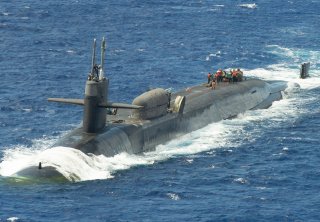Nuclear Warships Above the Waves: A Bad Idea That Should Just Die
Too expensive?
Here's What You Need to Remember: At the end of the Cold War in the early 1990s, the advantage of nuclear-powered surface ships lessened. During American unipolarity, there was not a clear reason for having expensive nuclear-powered surface ships when oil would do.
Today, nuclear power at sea is generally limited to submarines, aircraft carriers and ice breakers. In the 1950s however, Naval strategists thought nuclear power was the answer to fuel logistics: surface ships powered by nuclear fuel rather than oil would have virtually unlimited range. Rather than filling up on oil fuel at various ports of call, U.S. Navy ships would be limited only by crew requirements — food and water.
In order to test the nuclear-powered theory, the Navy commissioned these nuclear-powered surface ships. Here are the first ships that sailed around the world on nuclear power.
USS Long Beach
The USS Long Beach was commissioned in 1961 and was the world’s first nuclear-powered surface ship and the last true cruiser built by the United States after World War II.
The Long Beach was initially captained by Eugene Parks Wilkinson, who had the distinction of captioning the USS Nautilus, the world’s first nuclear-powered submarine.
It was luxurious in its day and even had teak wood decks. It had four large panels on its superstructure that together made up a 360-degree radar panel, the first of its kind.
The Long Beach was originally intended to have an all-missile armament but was outfitted with two traditional gun mounts, apparently at the express order of President Kennedy. It had two nuclear reactors that powered two propellers. Combined with a high amount of light-weight aluminum used during construction, the Long Beach was capable of 30 knots.
USS Bainbridge
The USS Bainbridge was a guided-missile destroyer commissioned in 1962 and the only member of the U.S Navy’s Bainbridge-class. In addition to an extensive missile armament, the Bainbridge could also launch torpedos. The Bainbridge saw service in Vietnam, off Libya, and in the Persian Gulf.
USS Enterprise
The USS Enterprise was commissioned in 1961 and was the first nuclear-powered aircraft carrier.
The Enterprise had a whopping 8 nuclear reactors onboard that powered four propeller shafts, and could make just over 33 knots, or about 39 miles per hour. Enterprise was one of the largest aircraft carriers ever built.
Operation Sea Orbit
In order to demonstrate the potential capabilities of nuclear power within the United States Navy, Operation Sea Orbit was planned. Sea Orbit was a 65-day circumnavigation of the world that did not require refueling stops.
Vice Admiral John McCain envisioned the operation as a modern-day recreation of the Great White Fleet, an early-20th century circumnavigation of the world by a coal-powered American surface group that made friendly port visits, partly to demonstrate the capabilities of the United States.
In addition to a show a force to allies and enemies, the Navy wanted to prove that a nuclear-powered task force could respond to threats worldwide on a moment's notice, without having to worry about fuel requirements.
The three ships that were in the operation, USS Enterprise, USS Long Beach, and USS Bainbridge, made up Task Force One. They stopped in Pakistan, Australia, New Zealand, Brazil, and South Africa among other places.
Though they did make port calls, no fuel was unloaded — only food and water. The massive journey was completed in just 65 days. The Navy's theory was validated.
End of the Cold War and defense budget cuts
At the end of the Cold War in the early 1990s, the advantage of nuclear-powered surface ships lessened. During American unipolarity, there was not a clear reason for having expensive nuclear-powered surface ships when oil would do.
All three ships of Sea Orbit-fame were stricken off U.S. Navy lists and sold for scrap in the mid-1990s.
Caleb Larson is a Defense Writer with The National Interest. He holds a Master of Public Policy and covers U.S. and Russian security, European defense issues, and German politics and culture. This article is being republished due to reader interest.
Image: Flickr.


